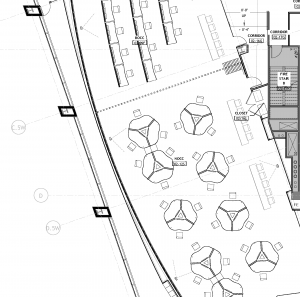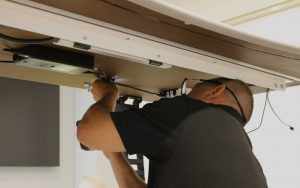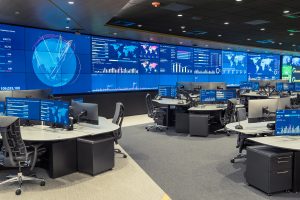Operations centers are incredibly complex environments that monitor large amounts of data 24/7. The average refresh rate for an operations center is 5-7 years. Because these spaces provide critical functions, it’s important to keep the technology up-to-date so everything continues to function at optimal levels. Audio/visual technology changes quickly, and it’s important that mission critical spaces don’t fall behind.
Once you pass 5 years since your last update, it’s worth taking stock of your current setup and assessing whether it’s time for a technology refresh.
Read on to learn more about each stage of designing, installing, and maintaining your mission critical space.
1. Establish Requirements
Every operations center project, whether a new space or a refresh of an existing command and control environment, should begin by establishing the requirements of the space. In addition to the floor plan or general room dimensions, the most fundamental part of this process is a simple assessment of what you want the space to accomplish. What is the operations center’s purpose? What will you be monitoring? These questions are the keys that unlock the rest of the details for your operations center so it can be brought to life.
Many of the decisions in a command center installation are driven by a combination of three things: functional performance, cost, and “wow” factor. For your space, what is the balance between these three factors, and are there others that should also be considered? Once these basic requirements are established, it’s on to the next stage.
2. Conceptual Architectural & AV Layouts
After establishing and reviewing requirements, it’s time to start visualizing the possibilities. Depending on whether you are looking for AV systems integration, console furniture, or both, this process can look a little different.

Before the design is finalized, it must meet internal design standards as well. Multiple design engineers will review the concepts and details to ensure quality and share insights.
Part of this design process also includes detailed AV layouts.
The AV drawings Constant produces give a precisely detailed view of exactly how your audiovisual system will be set up. AV design engineers determine drop locations and make a cable pull schedule. This occurs early in the design process to ensure that cables are pulled to the appropriate locations ahead of time, saving any future headache. Constant’s audiovisual design also includes details for equipment racks and AV schematics so that each element of your system is planned for ahead of time.
3. Full Color Renderings

4. Engineered Construction Documents
The next stage in your operations center’s life cycle is the creation of precisely engineered construction documents. Design engineers create exact, detailed specifications so the installers on site have a roadmap they can follow each step of the way. This ensures that everything is put in exactly the right place. Planning down to every last detail prevents unexpected problems and unnecessary expenses.
Engineered construction documents don’t just make the process easier; they save time and money. At Constant, we plan every last detail to make sure the integration works smoothly.
5. Equipment Staging, Programming & Testing
Programming is an essential component of all mission critical installations. Each operations center project by Constant features custom AV integration where a variety of equipment from different manufacturers is brought together to form a single solution. Programming the system is integral in making these disparate components work together. Our programming takes all the equipment and makes it work as if it is all one system with components designed to work together.
We program various components of your operations center technology, from the control system – which would be the touch panels that control the AV equipment– to the actual display wall controllers and switchers. Every element is configured so that the behavior of the device matches what the users need in the room.
Before installation we also stage and test your equipment to ensure that everything runs smoothly and as intended. This is an important stage in the cycle of your operations center so it is ready to run from day one.
6. Installation & Commissioning
The next stage in an operations center’s life cycle is when it all comes together: installation. From the complex cabling in AV racks to furniture assembly and equipment management, our install team is trained and experienced in every aspect of mission critical installation.

The installation of your operations center is every bit as important as the planning phase and is vital to the success of your mission critical operations. All the planning would be futile without an installation of equal caliber.
After the installation is complete, our technicians conduct commissioning, which is when they go through the entire system to make sure everything works as designed before handing the system over to you for operation.
7. End User Training
Once your operations center has been created, it’s important that your operators can truly own the function of the room.
In a typical operations center, there is always more than one audience: there will be managers who need to know what the room is capable of, end users who will be operating it day-to-day, people who will only use it occasionally, and an individual who will be the on-site point of contact for support and troubleshooting.
When conducting on-site training, Constant trains only a few end users – around 5 or 6 – at a time to ensure that everyone gets the attention they need to fully understand the details of the system. This also allows training to be broken into multiple sessions to accommodate different shift schedules or use cases.
Additionally, Constant creates reference guides which you and your team can use for a variety of reasons: to refresh information learned during training, or to train a new hire, for instance.
8. 5-7 Years Running 24/7 with Service & Support

Your center will run 24/7/365, and while it’s optimally designed for this purpose, we always prepare for the unforeseen.
We offer customized service level agreements to meet your needs and budget. Each agreement defines the elements of service covered such as turnaround time and which devices are covered. We also have a Support Operations Center at our headquarters where our service team can track and respond to requests.
9. Time for a Refresh
Once 5-7 years have passed, it’s time to start the process over again to ensure optimal function of your critical space. We can help you determine what updates may need to be made based on technology, staffing, and operational goals. Whether it’s changes to the audiovisual system, swapping out consoles, or a re-imagining of the space to accommodate growth, Constant can help you with it all.
If you’d like to learn more about creating your own operations center with Constant, contact us today for a free design and budget consultation.
About Constant:
Constant Technologies, Inc. provides AV integration for 24/7 video walls and custom operation center furniture. With 30+ years of experience, we can work with sensitive environments in the public and private sectors. Constant designs and installs projects of all scopes and sizes around the world. We also offer long-term service and support. We create solutions with the highest levels of security, aesthetics and functionality in mind.

